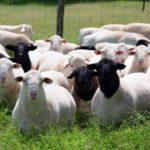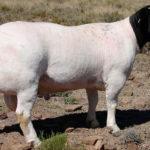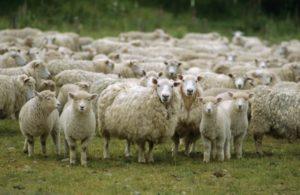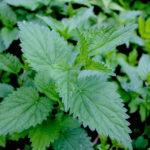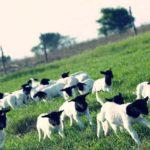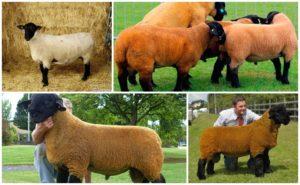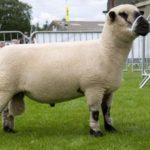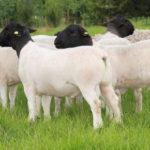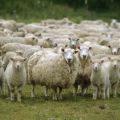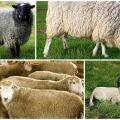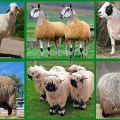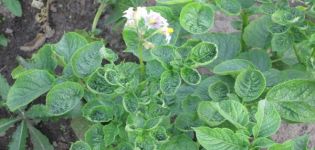Description and characteristics of dorper sheep, features of their maintenance
The Dorper breed of sheep is famous for its numerous advantages, including simplicity in care and maintenance, rapid growth, good productivity, high quality meat and leather. It will not work to get wool from these sheep, since the breed does not have it at all. But even in spite of its high cost, dorper sheep are widespread among farmers.
Origin
This breed was bred in the thirties of the XX century, and the homeland of the Dorper is South Africa. The variety was obtained as a result of crossing dorsets and Persian sheep, each of which is characterized by unpretentious maintenance and good productivity. Dorper representatives adopted fertility from dorsets. The breed owes its Persian ancestors the lack of wool and non-standard color. At first, the breed spread throughout Australia, and then was brought to the United States and Great Britain. And only after a while, the dorper appeared in Russia.
The breed was officially registered in 1930. The name "Dorper" was not obtained by chance: the word is formed from parts of two names - Dorset and Persian (the ancestors of the Dorpers).
Exterior and characteristics
Representatives of the meat breed differ:
- Strong physique. Animals have a knocked down, elongated body. The thighs and back of the back are especially well developed.
- Almost complete absence of hair. The available hair is very sparse, coarse, short, with an undercoat. Wool is distributed unevenly - most of it covers the chest, neck, back. The belly is practically bare. On the forehead, the hair may curl.
- White or light gray color. The skin color is white (on the legs, neck, trunk). Black areas cover the neck and head.
- Short, bare limbs.
- Lack of horns in females. Males have very small horns (2-3 centimeters high), and in most cases they do not grow at all.

Lambs have similar characteristics to adults, except for body size.
The Dorper breed has two varieties:
- white (there are no dark areas on the body);
- black-headed (head and neck are black).
Dorper crossbreeds with other breeds are popular. The Romanov breed most often takes part in breeding, and as a result of crossing, a hybrid with good qualities is obtained.
Pros and cons of dorpers
The high cost of dorper sheep is justified by a number of positive qualities.
The bareness of the breed can be perceived as a virtue - there is no need to spend resources on shearing sheep. In addition, dorpers are less susceptible to attack by external parasites.
Content requirements
The breed is unpretentious, so there is no need to comply with special conditions and maintenance requirements. Animals do well both in hot climates and in cooler regions. Dorpers are able to withstand even very low temperatures. Animals are also undemanding to the diet - the most common grass is a sufficient source of food for them. However, this fact does not mean at all that sheep are kept exclusively on pasture. By improving the quality of food, the resulting product will be much better.
Simplicity of caring for animals applies not only to adults, but also to young ones. Lambs, including newborns, do not need careful care.
Dorper representatives have the ability to adapt to any conditions in which they live. This is one of the reasons why farmers dream of raising such sheep.
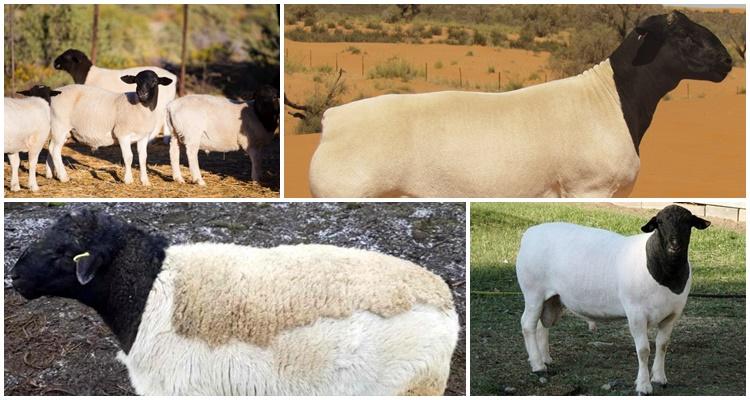
Feeding and care
These animals do not need special nutrition - dorpers can be kept on pasture. Even under these conditions, animals gain weight quickly. And yet, to improve the quality of the product, it is recommended to diversify food and include in the diet:
- clover;
- alfalfa;
- nettles;
- burdock;
- thistle;
- grain (because of the calorie content, such food is given only to pregnant and lactating females, as well as young animals during intensive growth);
- hay (used as a replacement for fresh grass);
- compound feed (used for feeding sheep during pregnancy and lactation, and also given to animals a few days before being sent for slaughter);
- salt and minerals (special dressing);
- root crops (in summer they are used as top dressing, in winter they are part of the diet);
- water (should be in the public domain, normally one adult has from 6 to 8 liters of water per day).
Dorpers spend most of their time in the pasture or in spacious enclosures. It is advisable that the hedge be disassembled, which would allow it to be transferred to another site when the grass runs out on the previous one.
In cold weather, the sheep are kept in the sheepfolds. Requirements for premises:
- normal lighting;
- lack of drafts;
- free space (area per animal in a group stall - 1.5 square meters, in an individual stall - at least 2.5, for a female with one lamb - 3.2, and for each subsequent stall, the space is increased by 0.7);
- the presence of ventilation, heating.
Food and water are in long troughs.
Breeding features
The breed reaches puberty early.The readiness for reproduction in females occurs at 8 months, in males - at 5. However, it is recommended to start breeding sheep when they reach 1.5 years. The males are very fertile and are capable of inseminating up to 100 sheep at a time. To improve the quality of the seed, it is desirable to maintain the same ratio - one male to 15-20 females.

Childbirth can be repeated every 8 months, and at the same time it is not tied to a specific season. Bearing lasts 4-5 months.
Frequent diseases and prevention from them
Representatives of the Dorper breed are resistant to diseases, however, if the general conditions of detention are not observed, the risk of such problems increases:
- brucellosis;
- smallpox;
- foot and mouth disease;
- infectious mastitis;
- footrot;
- fractures and dislocations of the limbs.
In order to prevent diseases, they resort to the following measures:
- regular cleaning of the stall;
- routine vaccination;
- compliance with the quarantine to which new animals are sent (lasts 2 weeks);
- deworming in autumn and spring.
Dorpers in Russia
In Russia, this breed is almost never found in its pure form. And the reason is not at all in the climate - the dorpers would perfectly take root in the middle lane. The determining factor is that keeping sheep of this breed is not profitable. For this reason, Dorper seed material is brought into the country and with its help females of local breeds (most often Romanovs) are fertilized.
The resulting hybrids are inferior in their qualities to the original, but, on the whole, the result is satisfactory. Dorper is a popular beef breed that is distinguished by its unpretentiousness, fertility, and good productivity. Despite the high cost and lack of wool, these sheep are able to generate a good income for farmers.

